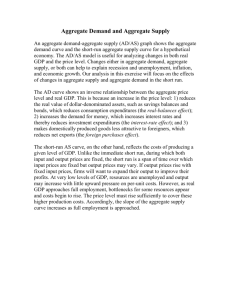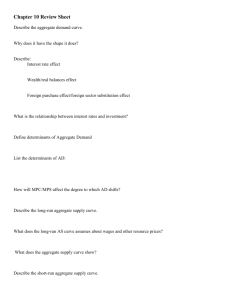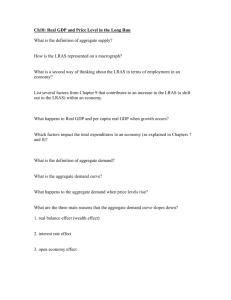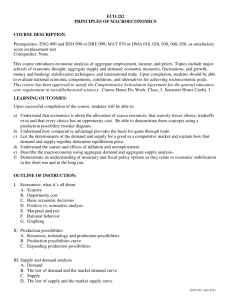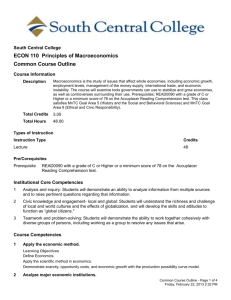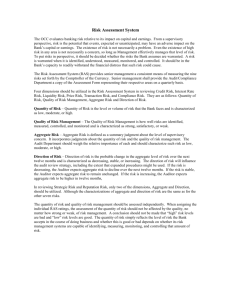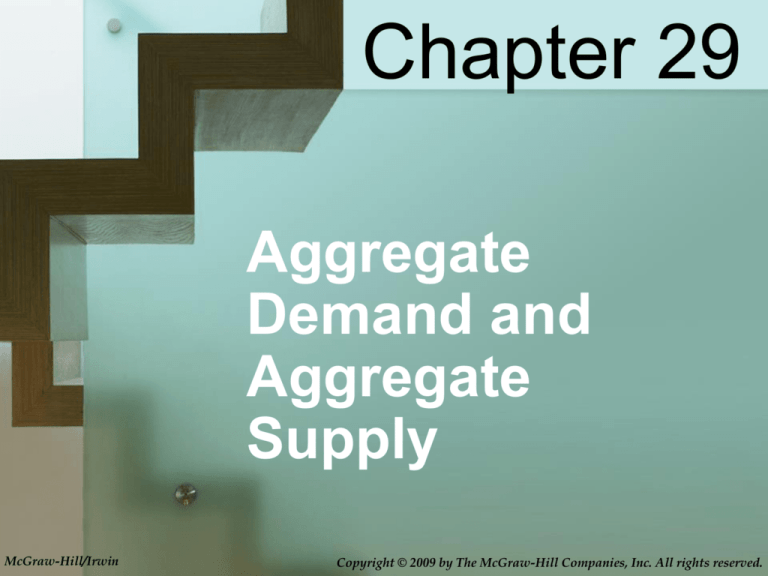
Chapter 29
Aggregate
Demand and
Aggregate
Supply
McGraw-Hill/Irwin
Copyright © 2009 by The McGraw-Hill Companies, Inc. All rights reserved.
Chapter Objectives
• Aggregate demand (AD)
• Aggregate supply (AS)
• How AD and AS determine
equilibrium price and real GDP
• The AD-AS model
29-2
Aggregate Demand
• Amount of real GDP purchased at
each price level
• Why the downward slope?
– No income or substitution effect
– Real-balances effect: purchasing power
of held assets (C)
– Interest-rate effect: demand for $ (I)
– Foreign purchases effect (X)
• Consumption, investment, and
net exports
29-3
Price Level
Aggregate Demand Curve
Aggregate
Demand
AD
Real Domestic Output, GDP
29-4
Aggregate Demand
• Determinants of aggregate demand
– Fixed variables along the demand curve
• Change in fixed variable (C I G X)
• Multiplier effect
• Consumer spending variables:
– Consumer wealth: value of assets
– Consumer expectations: income and prices
– Household borrowing: borrowing vs. repaying
– Personal taxes
29-5
Aggregate Demand
• Investment spending variables
–Real interest rates (related to
money supply)
–Expected returns on investment
• Future business conditions
• Technology
• Degree of excess capacity
• Business taxes
–r=i
29-6
Aggregate Demand
• Government spending
• Remember - Non-transfers only
• Net export spending variables
• National income abroad
• Exchange rates
29-7
Dempsey may have gained us a point…
…but Gerrard can take solace in
the favorable exchange rate.
29-8
Changes in Aggregate Demand
Price Level
Increase in
Aggregate
Demand
Decrease in
Aggregate
Demand
AD2
AD1
AD3
Real Domestic Output, GDP
29-9
Aggregate Supply
• Amount real GDP produced at
each price level
• Three time horizons
• Immediate short run
–Few days to a few months
–All prices fixed (input and output)
–Implicit price agreements (output)
–Contractual agreements (input)
29-10
Price Level
Aggregate Supply
ASISR
Immediate-shortrun Aggregate
Supply
Qf
Real Domestic Output, GDP
29-11
Aggregate Supply
29-12
Aggregate Supply
• Short run
–Input prices fixed
–Output prices variable
–Real profit changes
• Long run
–All prices variable
–Full employment GDP
–All prices adjust
29-13
Aggregate Supply
Slope not constant: per unit production cost
and firm capacity
Price Level
Aggregate Supply
(Short Run)
0
Competition for
resources hikes
ATC
Plentiful resources limit
growth of ATC
Qf
Real Domestic Output, GDP
29-14
Aggregate Supply
Price Level
ASLR
Long-run
Aggregate
Supply
Qf
Real Domestic Output, GDP
29-15
Aggregate Supply
• Determinants of aggregate supply
• Change in input price (land, labor, capital)
– Domestic resource prices
– Prices of imported resources
• Change in productivity
• Change in legal-institutional
environment
– Business taxes and subsidies
– Government regulation
29-16
Aggregate Supply
AS3
AS1
AS2
Price Level
Decrease in
Aggregate
Supply
Increase in
Aggregate
Supply
Real Domestic Output, GDP
29-17
Equilibrium
Real Output
Demanded
(Billions)
Price Level
(Index Number)
Real Output
Supplied
(Billions)
$506
108
$513
508
104
512
510
100
510
512
96
507
514
92
502
Equilibrium Price Level and
Equilibrium Real GDP
29-18
Equilibrium
Price Level
AS
Equilibrium
100
92
a
b
AD
502
510 514
Real Domestic Output, GDP
(Billions of Dollars)
29-19
Changes in Equilibrium
Increase in Aggregate Demand
Price Level
AS
Demand-Pull
Inflation
P2
P1
AD1
**increase in
price level
diminishes the
multiplier effect
AD
Qf
Q1 Q2
Real Domestic Output, GDP
29-20
Changes in Equilibrium
Decrease in Aggregate Demand
Price Level
AS
b
P1
c
P2
**No change in
price level
protects full
multiplier effect
a
Creates a
Recession
AD1
AD2
Q1 Q 2 Qf
Real Domestic Output, GDP
29-21
Changes in Equilibrium
• Decrease in aggregate demand
– Recession and cyclical unemployment
– Deflation?
• Downward price inflexibility:
– Fear of price wars
– Menu costs
– Wage contracts
– Morale, effort, and productivity
• Efficiency wages: output per hour of input
– Minimum Wage
29-22
Changes in Equilibrium
Decrease in Aggregate Supply
Price Level
AS2
Cost-Push
Inflation
P2
P1
AS1
b
a
AD
Q1 Qf
Real Domestic Output, GDP
29-23
Changes in Equilibrium
Increases in Aggregate Supply –
Full-Employment With Price-Level Stability
Price Level
AS1
P3
P2
P1
AS2
b
c
a
AD2
AD1
Q1
Q2Q3
Real Domestic Output, GDP
29-24
Impact of Oil Prices
• Aggregate supply shocks
• Cost push inflation
• Oil prices affected core inflation prior
to 1980
• Core inflation unaffected post 1980
– Energy efficiency
– Composition of GDP
– Fed vigilance
29-25
Key Terms
• aggregate demandaggregate supply (ADAS) model
• aggregate demand
• real-balances effect
• interest-rate effect
• foreign purchases effect
• determinants of
aggregate demand
• aggregate supply
• immediate-short-run
aggregate supply curve
• short-run aggregate
supply curve
• long-run aggregate
supply curve
• determinants of
aggregate supply
• productivity
• equilibrium price level
• equilibrium real output
• menu costs
• efficiency wages
29-26
Next Chapter Preview…
Fiscal Policy,
Deficits, and Debt
29-27
Appendix
The Relationship of
the Aggregate
Demand Curve to
the Aggregate
Expenditures Model
Deriving the AD Curve
Aggregate Expenditures
(billions of dollars)
AE1 (at P1 )
AE2 (at P2 )
AE3 (at P3 )
As Price Levels
Increase…
Price Level
45°
P3
Real GDP
Declines
P2
P1
AD
Q1
Q2
Q3
Real Domestic Product, GDP
29-29
Deriving the AD Curve
AE2 (at P1 )
Aggregate Expenditures
AE1 (at P1 )
Increase in
Aggregate
Expenditures
Price Level
45°
Increase in
Aggregate
Demand
P1
AD2
AD1
Q1
Q2
Real Domestic Product, GDP
29-30
Deriving the AD Curve
AE2 (at P1 )
Aggregate Expenditures
AE1 (at P1 )
The Shift in the
Aggregate Demand
Curve is a Multiple
of the initial Change
in Aggregate
Expenditures
Price Level
45°
P1
AD2
AD1
Q1
Q2
Real Domestic Product, GDP
29-31



